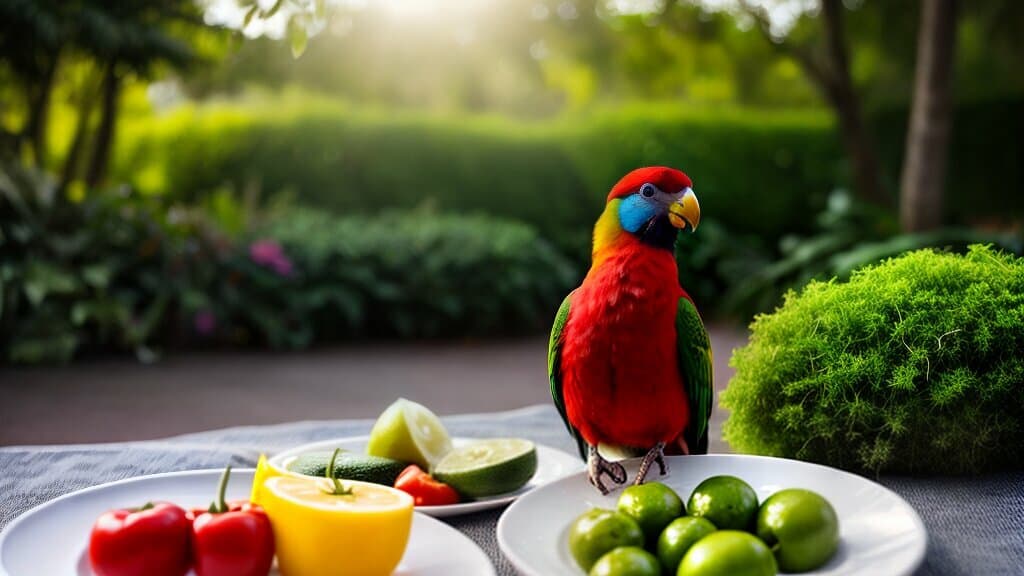If you’re a kakariki owner looking to diversify your bird’s diet, you may be wondering if vegetables are a safe and nutritious option. In this comprehensive guide, we will explore whether kakarikis can eat vegetables, introduce you to safe and nutritious vegetable options for your bird, and provide guidance on how to incorporate them into their diet.
Can Kakarikis eat vegetables? Yes, Kakarikis can indeed eat a wide variety of vegetables. They thrive on a diet rich in fresh produce, including leafy greens, carrots, bell peppers, peas, and broccoli. It’s important, however, to ensure these foods are washed thoroughly to remove any potential pesticides. Always consult with an avian veterinarian to optimize your Kakariki’s diet based on their specific health and nutritional needs. Remember, these vibrant birds’ balanced diet promotes longevity and overall health.
We will also discuss the benefits of a healthy and balanced diet for kakarikis, potential risks and precautions to consider, and practical feeding tips and recommendations. By following our guide, you can ensure your kakariki receives all the nutrition they need for optimal health and happiness.
Key Takeaways:
- Kakarikis can eat vegetables as part of a healthy and balanced diet.
- Introduce vegetables to your bird’s diet gradually and monitor their response.
- Some vegetables are toxic to kakarikis, so choosing safe options is essential.
- Ensure a varied diet that includes different food groups, treats, supplements, and sufficient water intake.
Understanding the Kakariki Diet
Kakarikis are primarily seed eaters but consume various fruits, flowers, nectar, and insects. In the wild, their diet varies based on the season and the plant species available to them. It’s important to remember this when considering the best diet for your pet kakariki.
As a pet owner, it’s essential to provide a balanced and healthy diet for your kakariki to ensure their optimal health and longevity. A high-quality seed mix should form the basis of their diet, but it’s crucial to supplement this with other food groups to ensure they receive all the nutrients they need.
Some commercial bird food brands offer complete nutrition for kakarikis, but it’s still important to provide a variety of foods to keep them happy and healthy. In the wild, kakarikis eat a diverse diet, and this practice should continue in captivity.
Introducing Vegetables to a Kakariki Diet
If you’re considering introducing vegetables to your kakariki’s diet, it’s important to do so gradually. This is because kakarikis are primarily seed eaters, and their digestive system may take some time to adjust to the addition of vegetables.
Start by offering small amounts of vegetables alongside their normal meals. Over time, you can gradually increase the amount of vegetables in their diet, monitoring their response to ensure they are tolerating the new food well.
Best Approach to Introducing Vegetables
Before introducing vegetables, ensure that your kakariki is in good health and has no underlying health conditions that may affect their ability to digest new foods. Once you have the all-clear, you can begin by offering small amounts of cooked or raw vegetables.
You can also try mixing vegetables in with their usual seed mix. This can help encourage them to try new foods and make the transition to a vegetable-rich diet smoother.
As with any dietary change, monitoring your kakariki’s response over time is important. This ensures that they tolerate the new food well and benefit from the additional nutrition.
Safe and Nutritious Vegetable Options for Kakarikis
Introducing vegetables into a kakariki’s diet can be beneficial, but not all vegetables are safe for them to consume. For optimal health, providing safe and nutritious vegetable options in appropriate quantities is essential. Here are some recommended vegetables to include in your kakariki’s diet:
| Vegetable | Benefits | Recommended Quantity |
|---|---|---|
| Kale | High in calcium, vitamin C, and iron | A small bunch per week |
| Sweet potato | Rich in vitamins A and C, and dietary fibre | A small cube twice a week |
| Zucchini | Low in fat, high in water content, and a good source of vitamin C | Half a slice one to two times a week |
| Carrots | A good source of vitamin A, dietary fibre, and antioxidants | A small piece once a week |
| Peppers | High in vitamin C and antioxidants | A small slice twice a week |
| Broccoli | Rich in vitamins C and K, and dietary fibre | A small floret once a week |
Remember to introduce these vegetables gradually and monitor your kakariki’s response to ensure they are suitable for their digestive system. If your bird shows signs of discomfort or allergies, adjust their diet accordingly. The recommended quantities can also be adjusted to suit your bird’s individual needs.
Preparing Vegetables for Kakarikis
Proper preparation of vegetables is crucial to ensure that they are safe for your kakarikis to consume. This section will provide guidelines on washing, chopping, and cooking vegetables for your feathered friends.
Washing Vegetables
When preparing vegetables for kakarikis, make sure to wash them thoroughly to remove any dirt, pesticides, or other contaminants that could be harmful. Rinse them under running water and gently scrub them with a vegetable brush. Avoid using any soap or other cleaning solutions, as these could be toxic to your birds.
Chopping Vegetables
Chop vegetables into small, bite-sized pieces to make it easier for your kakarikis to eat them. Use a sharp knife to ensure clean cuts and avoid crushing or bruising the vegetables, which could make them unappetizing to your birds.
Cooking Vegetables
You can either serve vegetables raw or cook them for your kakarikis. If you choose to cook them, avoid using salt, oil, or seasoning, as these could harm your birds. Boil or steam vegetables until they are tender but not mushy. Allow them to cool before serving.
Presenting Vegetables
How you present vegetables can significantly affect whether your kakarikis will eat them. Try offering them in different ways, such as shredded, mashed or blended into a puree. You can also mix them with seeds or fruits to make a colourful meal. Be creative in your presentation, but remember that presentation shall not be harmful.
Monitoring Kakariki’s Response to Vegetables
As with any diet change, monitoring how your kakarikis respond to vegetables is essential. While some birds may take to them right away, others may experience digestive issues or other adverse reactions.
It’s essential to introduce vegetables gradually, offering small amounts alongside their regular food. Watch for any changes in your bird’s behaviour or droppings, which could indicate an adverse reaction.
If you do notice any problems, it’s best to stop offering vegetables and consult a veterinarian experienced with birds. They can help determine whether your kakarikis are suitable for a vegetable-rich diet and recommend a suitable course of action.
Remember, every bird is different, so it’s crucial to carefully monitor their response to changes in their diet. With patience and diligence, you can incorporate vegetables into your kakariki’s diet safely and effectively.
Balancing the Kakariki Diet with Vegetables
While incorporating vegetables into a kakariki’s diet offers numerous benefits, it’s essential to maintain a balanced nutritional intake by introducing them in moderation.
Vegetables should be fed in conjunction with a variety of other food groups to provide the necessary vitamins and minerals for a healthy bird. A balanced diet should include fresh fruits, high-quality seeds and pellets, and necessary supplements.
A good rule of thumb is to incorporate vegetables into a kakariki’s diet a few times a week, but always in small amounts. It’s essential to monitor your bird’s response to the vegetables and adjust the frequency and quantity accordingly.
When feeding vegetables, be sure to offer a variety of options to maintain the nutritional balance. A diet consisting of the same vegetables every day may lead to imbalances and deficiencies.
Finally, remember to consult with an avian veterinarian or bird nutritionist if you have any concerns regarding your kakariki’s diet. They can provide tailored advice and recommendations for your specific bird’s needs.
The Benefits of Vegetables for Kakarikis
Vegetables offer a plethora of benefits when added to a kakariki’s diet. They are packed with vitamins and minerals essential to a bird’s overall health. Vegetables are a great source of dietary fiber that promotes digestion and helps maintain a healthy weight.
By incorporating vegetables into a kakariki’s diet, you can prevent some diseases, such as cardiovascular problems and some types of cancer, thanks to their antioxidant properties. Vegetables can also help boost their immune system, preventing various infections.
Some of the most recommended vegetables to include in a kakariki’s diet are broccoli, spinach, carrots, sweet potato, peppers, and pumpkin. These vegetables offer different nutrients and can be served both cooked and raw.
It is essential to keep in mind that vegetables should never replace a bird’s primary diet, but rather complement it. Therefore, remember to monitor their vegetable intake to ensure they receive a balanced diet and all the necessary nutrients.
Adding vegetables to your kakariki’s diet will provide numerous health benefits, ensuring your bird lives a long, healthy, and happy life.
Potential Risks and Precautions
While vegetables are generally safe and beneficial for kakarikis, taking certain precautions is important to ensure their well-being. Here are some potential risks to be aware of when incorporating vegetables into your bird’s diet:
| Risk | Description |
|---|---|
| Toxic vegetables | Some vegetables, such as garlic, avocado, and onion, contain toxins that can be harmful to kakarikis. Avoid feeding these vegetables to your bird. |
| Overfeeding | Too much of any food, including vegetables, can lead to obesity and health problems. Don’t feed your kakariki large amounts of vegetables, and ensure they are getting a balanced diet. |
| Intolerance or allergy | Some birds may have an intolerance to certain vegetables, leading to digestive issues and discomfort. Watch your kakariki’s behaviour after introducing new foods and adjust their diet accordingly if necessary. |
It’s important to gradually introduce vegetables to your kakariki’s diet, observe their response, and monitor their overall health. If in doubt, consult a veterinarian or avian specialist for further guidance.
Feeding Tips and Recommendations
Introducing vegetables to your kakariki’s diet is an excellent way to provide them with essential nutrients and dietary fiber. However, it’s crucial to approach it gradually to ensure your bird’s digestive system can adjust accordingly. Here are some feeding tips and recommendations for incorporating vegetables into your kakariki’s diet:
Frequency and Portion Sizes
It’s best to initially introduce small amounts of vegetables and gradually increase the quantity, monitoring your bird’s response. As a general rule, vegetables should make up no more than 10% of your kakariki’s diet. One or two small servings per week should suffice.
It’s also essential to ensure your kakariki’s overall diet is well-balanced and incorporates all the necessary nutrients and components for optimal health.
Preparing and Presenting Vegetables
Proper preparation and presentation of vegetables can significantly impact your bird’s willingness to consume them. Rinse and chop vegetables into small pieces, and consider offering them in a variety of ways – such as skewered, hung up, or served in a dish. For particularly stubborn birds, offering vegetables alongside their favourite fruits or seeds could encourage them to try them.
Monitoring Your Kakariki’s Response
Monitoring your kakariki’s response to vegetables is crucial, especially during the initial stages. Keep an eye out for any signs of adverse reactions or digestive issues, such as bloating, diarrhea, or vomiting. If you notice any of these symptoms, it’s best to remove the vegetable from their diet and consult with a vet if necessary.
Recommended Vegetables
| Vegetable | Benefits | Suggested Quantity |
|---|---|---|
| Carrots | Rich in vitamin A, promotes healthy eyesight, and encourages healthy skin and feathers. | 1-2 thin slices per serving |
| Peas | High in vitamin K and vitamins C and A, with anti-inflammatory properties. | 6-8 peas per serving |
| Broccoli | High in vitamin K, as well as vitamins C and A, with anti-inflammatory properties. | 1-2 small florets per serving |
| Spinach | Rich in iron, vitamin A, and dietary fiber, promoting healthy bones and feathers. | 1-2 leaves per serving |
Creating a Varied Diet for Kakarikis
While vegetables offer an excellent addition to a kakariki’s diet, it’s crucial to ensure that their diet is varied and balanced.
In addition to vegetables, a healthy kakariki diet should include various seeds, fruits, and protein. Offering different types of food will keep your bird interested and prevent them from becoming bored with their diet.
When it comes to seeds, you can offer both commercial seed mixes and individual seed types such as millet or sunflower seeds. Fruits, such as apples, berries, and grapes, can provide essential vitamins and minerals and make for a tasty treat.
Protein is also an essential component of a kakariki’s diet. Offer cooked eggs, mealworms, or crickets as a source of protein. You can even offer hard-boiled eggs chopped up with vegetables for a delicious and nutritious meal.
By providing a varied diet, you can ensure that your kakarikis are receiving all the nutrition they need for optimal health and well-being.
Other Considerations for a Healthy Kakariki Diet
While vegetables are a great addition to a kakariki’s diet, it’s important to remember that they should not be the sole focus. Other aspects must be considered to ensure a balanced and nutritious diet.
Firstly, water intake is vital for kakarikis. They should always have access to fresh, clean water, which should be changed daily to prevent contamination.
Treats can also be given in moderation to supplement their diet. However, be mindful of the amount offered as too many treats can lead to obesity and other health concerns. Safe treat options include small amounts of fruits, nuts, and seeds.
If you notice that your kakarikis are not getting enough of specific nutrients, supplements can be added to their diet. However, it’s always best to consult a veterinarian first to ensure these supplements are safe and appropriate for your bird.
By combining vegetables with water intake, treats, and supplements as needed, you can create a comprehensive and healthy diet that will support your kakariki’s overall health and well-being.
Conclusion
In conclusion, it is clear that vegetables can be a valuable addition to a kakariki’s diet. By gradually introducing suitable vegetables and monitoring their response, you can ensure that your bird benefits from the additional vitamins, minerals, and dietary fibre offered by vegetables.
It is important to balance the inclusion of vegetables and the other essential components of a kakariki’s diet to ensure that they receive all the necessary nutrients for overall health and well-being. By creating a varied diet that includes a range of food groups and considering other factors such as water intake, treats, and supplements, you can help your kakariki thrive.
Ultimately, providing a nutritious and balanced diet for your kakariki is crucial for their happiness and longevity. By following the guidance provided in this article, you can be confident that your bird is receiving the best possible care and nutrition.
FAQ
Q: Can kakarikis eat vegetables?
A: Kakarikis can eat vegetables as part of a healthy diet.
Q: What is the kakariki diet?
A: The kakariki diet is primarily composed of seeds, but they also consume fruits, flowers, nectar, and insects.
Q: How do I introduce vegetables to a kakariki’s diet?
A: It’s best to introduce vegetables gradually to allow their digestive system to adjust. We will discuss the best approach in this section.
Q: What are safe and nutritious vegetable options for kakarikis?
A: We will provide a list of safe and nutritious vegetables that can be included in a kakariki’s diet.
Q: How should I prepare vegetables for kakarikis?
A: Proper washing, chopping, and cooking techniques will be discussed in this section.
Q: How can I monitor kakarikis’ response to vegetables?
A: We will provide guidance on signs of allergies or adverse reactions and how to adjust the diet accordingly.
Q: What are the benefits of vegetables for kakarikis?
A: Vegetables offer essential vitamins, minerals, and dietary fiber for the overall well-being of kakarikis.
Q: Are there any potential risks and precautions?
A: Certain risks, such as toxic vegetables, need to be considered. We will provide guidance on ensuring your kakariki’s safety.
Q: What are some feeding tips and recommendations?
A: We will provide practical tips and recommendations for feeding vegetables to kakarikis.
Q: How can I create a varied diet for kakarikis?
A: A varied diet is important, and we will discuss the importance of incorporating different food groups.
Q: What other considerations are there for a healthy kakariki diet?
A: This section will touch on aspects such as water intake, treats, and supplements to ensure all nutritional needs are met.
Conclusion
Kakarikis can eat vegetables as part of a healthy and balanced diet. By carefully introducing and monitoring their response, providing suitable vegetable options, and maintaining a varied diet, you can ensure your kakarikis are happy, thriving, and receiving all the nutrition they need.



Have comments or questions about this article? Then get involved!
Spotted an error or something we have missed? Let us know